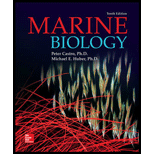
Concept explainers
There are marked differences in the type of organisms found at four different locations at the same tidal height along a rocky shore. What might account for this? Offer at least three possible explanations.
To mention: The three possible explanations on the account for marked differences in the type of organisms found at four different locations at the same tidal height along a rocky shore.
Introduction: Rocky shores are the shores that are made from solid rock formed at the intertidal coastal area. Epifauna are the animals that live on the surface of rock or sand or even other organisms. The organisms that inhabits in the rocky intertidal area are fully exposed to the elements and experience a physical stress due to the exposure.
Explanation of Solution
Rocky shores can be characterized as a habitat to some of the most biologically diverse communities that are present throughout the world. As the ecosystem lies at the interface of sea and land, it exposes the organisms to the terrestrial and marine habitats alternately in rhythm with the tidal cycle. The organisms that are found in different locations of the rocky shore may vary and the marked differences may be due to the reasons as follows:
Physical factors: The physical factors may change the appearance and adaptations of the organisms living along the rocky shores. The physical factors are as follows:
- Exposure to the wave action: Locations on the rocky shore have different types of wave action including high, low, and moderate waves and the organisms living on such area have difference in their adaptation and appearances.
- The type of rocky substrate: Rocky substrate to which the organisms are struck varies in terms of stability, color, and other particulars.
- Relative exposure to light.
- Abrasion by sand due to proximity to a sandy shore.
- Presence of seeping fresh water and pollutants.
Biotic factors: In addition to the physical factors, there are some biotic or biological factors which are as follows:
- Food
- Predation
- Competition for the space
Want to see more full solutions like this?
Chapter 11 Solutions
Marine Biology (Botany, Zoology, Ecology and Evolution)
- In one paragraph show how atoms and they're structure are related to the structure of dna and proteins. Talk about what atoms are. what they're made of, why chemical bonding is important to DNA?arrow_forwardWhat are the structure and properties of atoms and chemical bonds (especially how they relate to DNA and proteins).arrow_forwardThe Sentinel Cell: Nature’s Answer to Cancer?arrow_forward
- Molecular Biology Question You are working to characterize a novel protein in mice. Analysis shows that high levels of the primary transcript that codes for this protein are found in tissue from the brain, muscle, liver, and pancreas. However, an antibody that recognizes the C-terminal portion of the protein indicates that the protein is present in brain, muscle, and liver, but not in the pancreas. What is the most likely explanation for this result?arrow_forwardMolecular Biology Explain/discuss how “slow stop” and “quick/fast stop” mutants wereused to identify different protein involved in DNA replication in E. coli.arrow_forwardMolecular Biology Question A gene that codes for a protein was removed from a eukaryotic cell and inserted into a prokaryotic cell. Although the gene was successfully transcribed and translated, it produced a different protein than it produced in the eukaryotic cell. What is the most likely explanation?arrow_forward
- Molecular Biology LIST three characteristics of origins of replicationarrow_forwardMolecular Biology Question Please help. Thank you For E coli DNA polymerase III, give the structure and function of the b-clamp sub-complex. Describe how the structure of this sub-complex is important for it’s function.arrow_forwardMolecular Biology LIST three characteristics of DNA Polymerasesarrow_forward
 Concepts of BiologyBiologyISBN:9781938168116Author:Samantha Fowler, Rebecca Roush, James WisePublisher:OpenStax College
Concepts of BiologyBiologyISBN:9781938168116Author:Samantha Fowler, Rebecca Roush, James WisePublisher:OpenStax College Biology Today and Tomorrow without Physiology (Mi...BiologyISBN:9781305117396Author:Cecie Starr, Christine Evers, Lisa StarrPublisher:Cengage Learning
Biology Today and Tomorrow without Physiology (Mi...BiologyISBN:9781305117396Author:Cecie Starr, Christine Evers, Lisa StarrPublisher:Cengage Learning Biology: The Dynamic Science (MindTap Course List)BiologyISBN:9781305389892Author:Peter J. Russell, Paul E. Hertz, Beverly McMillanPublisher:Cengage LearningBasic Clinical Lab Competencies for Respiratory C...NursingISBN:9781285244662Author:WhitePublisher:Cengage
Biology: The Dynamic Science (MindTap Course List)BiologyISBN:9781305389892Author:Peter J. Russell, Paul E. Hertz, Beverly McMillanPublisher:Cengage LearningBasic Clinical Lab Competencies for Respiratory C...NursingISBN:9781285244662Author:WhitePublisher:Cengage





